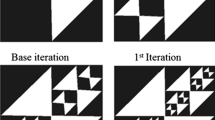Abstract
A novel pattern of fractal antenna deploying Swastika slotted geometry up to second iteration is used for optimization in this paper which enhanced its utilities for S-band. Swastika Slotted Fractal Antenna has been designed and fabricated by the use of FR4 substrate material which has 1.6 mm as its substrate thickness, 4.4 as dielectric constant and 0.02 as loss tangent with help of Zeland IE3D software and MATLAB software. The comparison between Genetic Algorithm and Bat Algorithm revealed that results of BA are superior than GA for the designed geometry. The testing of proposed fabricated antenna has been done by using Rohde and Schwarz ZVL Vector Network Analyzer and obtained experimental results are in good agreement with optimized simulated results. Also, fabricated SSFA resonate at 2.49, 2.70, 2.96 and 3.96 GHz with corresponding values of S-parameter (S 11 ) as −16.78, −18.87, −28.66 and −11.48 dB respectively.













Similar content being viewed by others
References
Werner, D., Gregory, M., Jiang, Z. H., & Brocker, D. E. (2015). Optimization methods in antenna engineering. In Z. N. Chen (Ed.), Handbook of antenna technologies (pp. 1–47). Springer. https://link.springer.com/referenceworkentry/10.1007/978-981-4560-75-7_15-1.
Dhaliwal, B. S., & Pattnaik, S. S. (2013). Artificial neural network analysis of Sierpinski Gasket fractal antenna: A low cost alternative to experimentation. Advances in artificial neural systems (pp. 1–7). Cairo: Hindawi Publishing Corporation.
Kaur, R., & Rattan, M. (2014). Optimization of return loss of differentially fed microstrip patch antenna using ANN and firefly algorithm. Wireless Personal Communications, 80(4), 1547–1556.
Ozkaya, U., & Seyfi, L. (2015). Dimension optimization of microstrip patch antenna in X/Ku band via artificial neural network. Procedia-Social and Behavioral Sciences, World Conference on Technology, Innovation and Entrepreneurship, 195, 2520–2526.
Lukes, Z., & Raida, Z. (2005). Multi-objective optimization of wire antennas: Genetic algorithms versus particle swarm optimization. Radioengineering, 14(4), 91–97.
Herscovici, N., Osorio, M. F., & Peixeiro, C. (2002). Miniaturization of rectangular microstrip patches using genetic algorithms. IEEE Antennas and Wireless Propagation Letters, 1(1), 94–97.
Neyestanak, A. A. L., Kashani, F. H., & Barkeshli, K. (2007). W-shaped enhanced-bandwidth patch antenna for wireless communication. Wireless Personal Communications, 43(4), 1257–1265.
Primson, K. P. R. C., & Anita, R. (2014). Antenna design for wimax applications using Artificial Bee Colony algorithm. Journal of Theoretical and Applied Information Technology, 68(3), 493–503.
Kumari, U. R., Rao, P. M., & Raju, G. S. N. (2016). Generation of optimized beams from concentric circular antenna array with dipole elements using BAT Algorithm. Microelectronics, Electromagnetics and Telecommunications, Lecture Notes in Electrical Engineering, 372, 547–552.
Kumar, K. A., Ashwath, R., Kumar, D. S., & Malmathanraj, R. (2010) Optimization of multislotted rectangular microstrip patch antenna using ANN and Bacterial Foraging Optimization. In: IEEE Asia-Pacific International Symposium on Electromagnetic Compatibility, Beijing, China (pp. 449–452).
Mandelbrot, B. B. (1983). The fractal geometry of nature. New York: Freeman.
Gianvittorio, J. P., & Samii, Y. R. (2002). Fractal antennas: A novel antenna miniaturization technique, and applications. IEEE Antennas Propagation Magazine, 44(1), 20–36.
Werner, D. H., Haup, R. L., & Werner, P. L. (1999). Fractal antenna engineering: The theory and design of fractal antenna arrays. IEEE Antennas and Propagation Magazine, 41(5), 37–58.
Werner, D. H., & Ganguly, S. (2003). An overview of fractal Antenna engineering research. IEEE Antennas and Propagation Magazine, 45(1), 38–57.
Li, J., Jiang, T., Cheng, C., & Wang, C. (2013). Hilbert fractal antenna for UHF detection of partial discharges in transformers. IEEE Transactions on Dielectrics and Electrical Insulation, 20(6), 2017–2024.
Baliarda, C. P., Romeu, J., & Cardama, A. (2000). The Koch monopole: A small fractal antenna. IEEE Transaction on Antennas and Propagation, 48(11), 1773–1781.
Kim, I. W., Yoo, T., Yook, J., & Park, H. (2001). The Koch Island fractal microstrip patch antenna. In: IEEE Antennas and Propagation Society International Symposium, Boston, MA, USA (vol. 2, pp. 736–739).
Puente, C., Romeu, J., Pous, R., & Cardama, A. (1998). On the behavior of the Sierpinski multiband fractal antenna. IEEE Transaction on Antennas and Propagation, 46(4), 517–524.
Chowdary, P. S. R., Prasad, A. M., Rao, P. M., & Anguera, J. (2015). Design and performance study of Sierpinski fractal based patch antennas for multiband and miniaturization characteristics. Wireless Personal Communications, 83(2), 1713–1730.
M.K. A. Rahim, N. Abdullah, and M. Z. A. A. Aziz (2005) Microstrip Sierpinski carpet antenna design. IEEE Asia-Pacific Conference on Applied Electromagnetics (pp. 58-61).
Chen, W. L., Wang, G. M., & Zhang, C. X. (2008). Small-size microstrip patch antennas combining Koch and Sierpinski fractal shapes. IEEE Antennas and Wireless Propagation Letters, 7, 738–741.
Sharma, A., & Vishwakarma, R. K. (2014). Microstrip antenna with Swastik slot for UWB applications. In: IEEE Students’ Conference on Electrical, Electronics and Computer Science, Bhopal (pp. 1–5).
IE3D version 14.0, Zeland Software Inc., Fremont, CA, 2008.
Yang, X. S., & Gandomi, A. H. (2012). Bat algorithm: a novel approach for global engineering optimization. Engineering Computations, 29(5), 464–483.
Tsai, P. W., Pan, J. S., Liao, B. Y., Tsai, M. J., & Istanda, V. (2012). Bat Algorithm inspired algorithm for solving numerical optimization problems. Applied Mechanics and Materials, 148–149, 134–137.
Yang, X. S. (2013). Bat algorithm: literature review and applications. International Journal of Bio-Inspired Computation, 5(3), 141–149.
Author information
Authors and Affiliations
Corresponding author
Rights and permissions
About this article
Cite this article
Kaur, G., Rattan, M. & Jain, C. Optimization of Swastika Slotted Fractal Antenna using Genetic Algorithm and Bat Algorithm for S-band Utilities. Wireless Pers Commun 97, 95–107 (2017). https://doi.org/10.1007/s11277-017-4495-6
Published:
Issue Date:
DOI: https://doi.org/10.1007/s11277-017-4495-6




